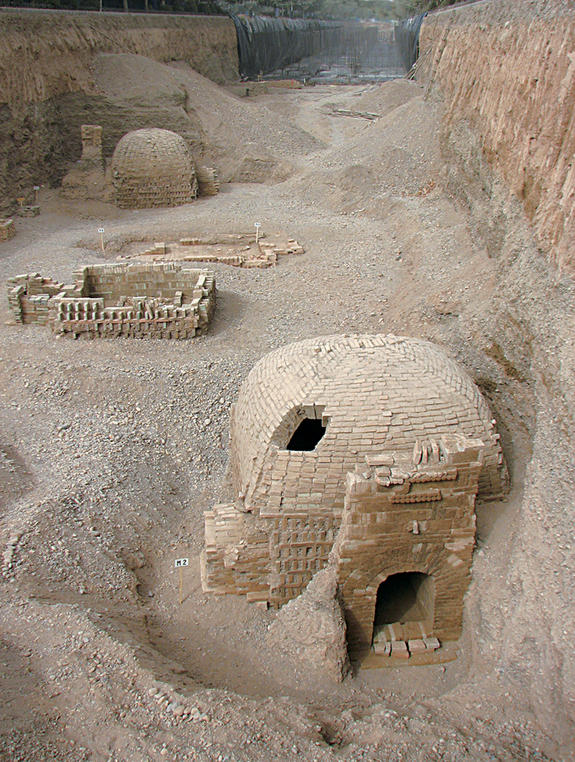A cemetery dating back roughly 1,700 yearshas been discovered along part of the Silk Road, a series of ancient trade routes that once connected China to the Roman Empire.
在丝绸之路上找到了一个1700年历史之久的墓地。丝绸之路是一系列的古代贸易路线,曾经链接着中国和罗马帝国。

The cemetery was found in the city of Kucha, which is located in present-day northwest China. Ten tombs were excavated, seven of which turned out to be large brick structures.
这个墓地在如今中国西北部的库车县被找到。已经有10个坟墓被挖掘出土,其中7个是大型的砖石结构。
One tomb, dubbed "M3," contained carvings of several mythicalcreatures, including four that represent different seasons and parts of the heavens: the White Tiger of the West, the Vermilion Bird of the South, the Black Turtle of the North and the Azure Dragon of the East.
其中一本被标上"M3"的坟墓里包含有神兽的雕刻,其中有四只代表一年四季以及天堂的各个部分:西边的白虎,南边的朱红鸟,北边的黑龟,东边的青龙。
The M3 tomb also "consists of a burialmound, ramp, sealed gate, tomb entrance, screen walls, passage, burial chamberand side chamber" the researchers wrote in a report published recently inthe journalChinese Cultural Relics.
这个M3坟墓还包含有一座古坟,斜坡,密封的门,坟墓入口,屏风的墙,过道,墓室,以及偏殿,研究人员最近在《中国文化遗迹》杂志上写到。
The cemetery was first found in July 2007and was excavated by the Xinjiang Institute of Cultural Relics and Archaeology,with assistance from local authorities. The research team, led by Zhiyong Yu,director of the Xinjiang Archaeological Institute, published the findings in Chinese in the journal Wenwu. The article was recently translated into Englishand published in the journal Chinese Cultural Relics.
这座墓地在2007年7月份的时候首次被发现,由新疆文化遗产和考古研究院负责开挖,挖掘工作得到当地政府的支持。研究团队将他们的发现发表在了中国的期刊《文物》上。这篇文章最近被翻译成英语,并发布在了《中国文化遗迹》杂志上。
Who was buried here?
谁被埋葬在这里?
The identity of the people buried in the cemetery is a mystery. The cemetery had been robbed in the past and no writing was found that indicates the names of those buried or their positions in life.
墓地主人的身份依然是个迷。这座墓地曾经被盗过,而且墓地中没有任何的文字记录来表明这些死者的名字以及他们的职位。
The seven large brick tombs were likelyconstructed for people of wealth, the researchers said.
研究人员说,其中那7个砖石结构的坟墓可能是为富人建造的。
But, when the skeletal remains were analyzed, the researchers found that the tombs had been reused multiple times. Some of the tombs contain more than 10 occupants, and the"repeated multiple burials warrant further study," the researcherswrote.
但是在对遗骸进行分析后,研究人员发现这些坟墓被重复利用了多次。有些坟墓中包括有10多个的死者,多次的重复埋葬有待于进一步的研究,研究人员写到。
City on the Silk Road
丝绸之路上的城市
The excavators think the cemetery datesback around 1,700 years, to a time when Kucha was vital to controlling the Western Frontiers (Xiyu) of China. Since the SilkRoad trade routes passed through the Western Frontiers, control of this key region was important to China's rulers.
挖掘者认为这个墓地可追溯到1700年前,在当时的中国,库车在控制西部前线(西域)上扮演着关键的角色。由于丝绸之路的路线有经过西域,所以控制这个关键的区域对中国统治者来说是非常重要的。
"In ancient times, Kucha was called Qiuci in Chinese literature. It was a powerful city-state in the oasis of the Western Frontiers" the researchers wrote.
“在古代,库车的名字在中国文学中叫做龟兹,是建立在西域绿洲上的一个非常强大的城邦,研究人员写到。
For the dynasties that flourished in China around 1,700 years ago "the conquest and effective governance of Kucha would enable them to control all the oasis city-states in the Western Frontiers," the researchers said.
研究人员写到,对于1700年前的中国朝代来说,如果能征服并有效的管理龟兹的话,那么他们就能够控制住西域所有的绿洲城邦。
In fact, one ancient saying was, "ifyou have Kucha, only one percent of the states in the Western Frontiers remain unsubmissive."
实际上,有一句俗语就是这样说的:“如果你拥有了龟兹,那么西域99%的城邦都会服从你。”
Chinese Cultural Relics is a new journal that translates Chinese-language articles, originally published in the journal Wenwu, into English. The discovery of the 1,700-year-old cemetery was included in its inaugural issue.
《中国文化遗迹》杂志是一本新创立的期刊,专门把发表在《文物》杂志上的原创文章翻译成英文。其创刊号上就发表了这座1700年墓地的发现。












